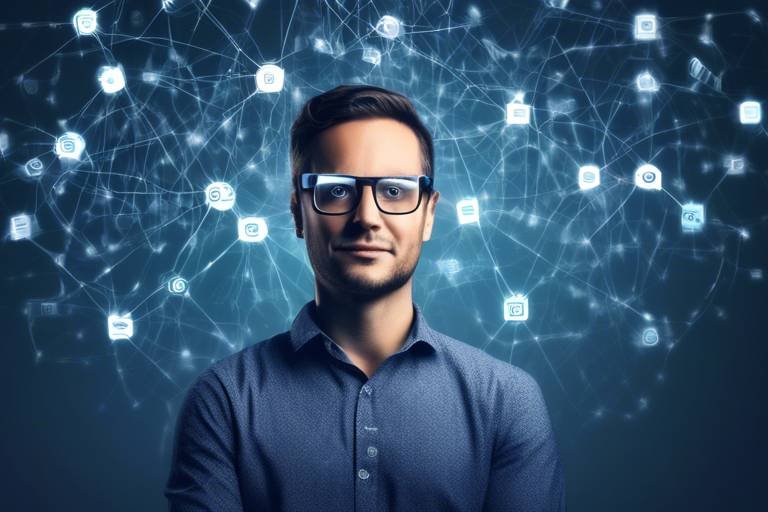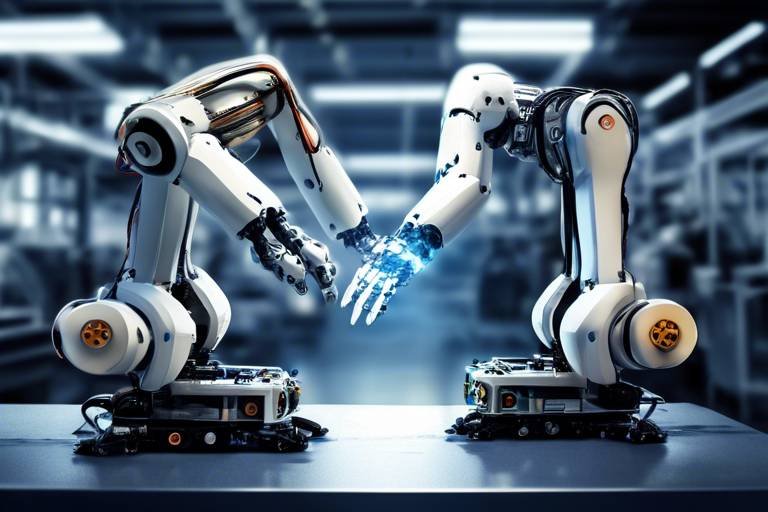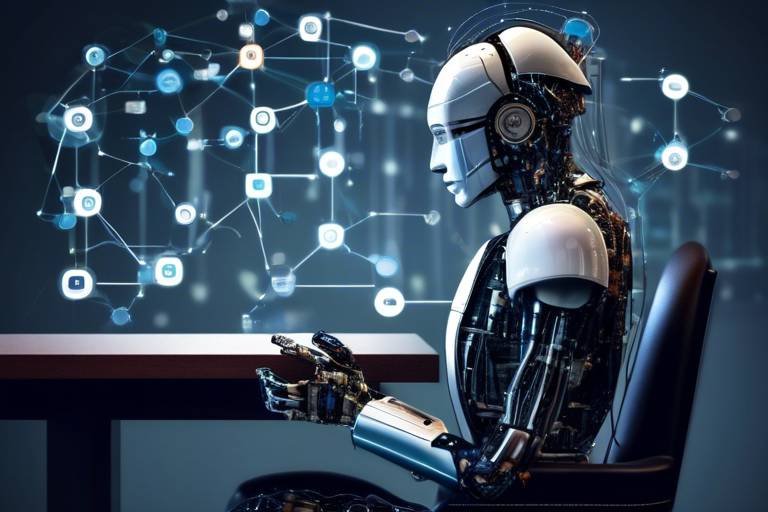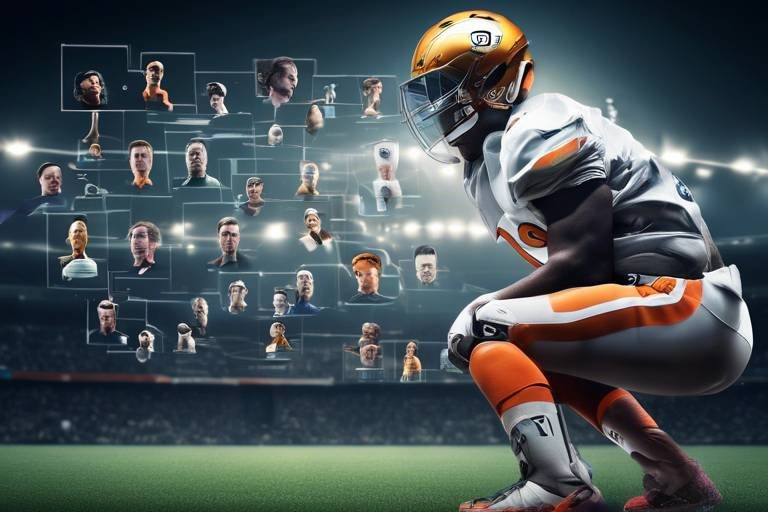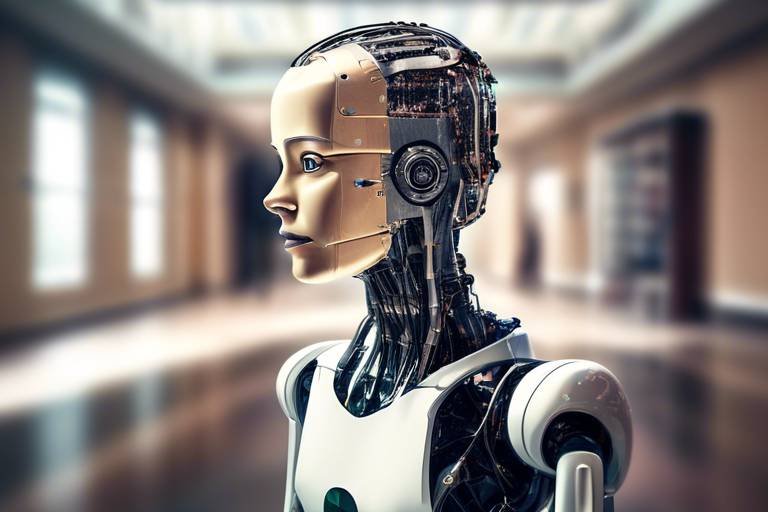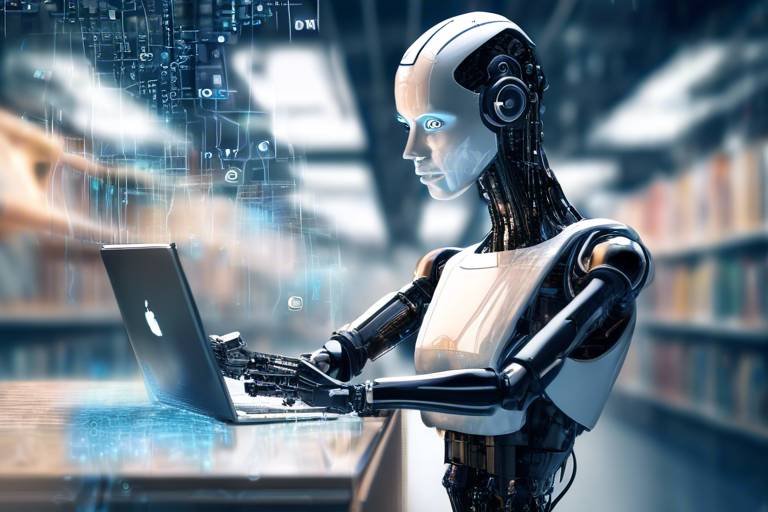AI in Computer Vision: Trends, Innovations and Future Prospects
Artificial Intelligence (AI) is not just a buzzword; it’s a revolutionary force reshaping entire industries, and one of the most exciting areas of this transformation is computer vision. Imagine a world where machines can see and interpret the visual world just like humans do. This is not science fiction; it’s happening right now! From smartphones recognizing faces to autonomous vehicles navigating complex environments, AI is making significant strides in enabling computers to understand and process images and videos.
As we dive into the current landscape, it’s essential to recognize the trends that are driving the integration of AI in computer vision. Deep learning, a subset of AI, has become the backbone of many computer vision applications. By mimicking the way the human brain works, deep learning algorithms can analyze vast amounts of data and identify patterns that were previously undetectable. This capability is paving the way for advancements in image recognition, allowing machines to identify objects, people, and even emotions with remarkable accuracy.
Moreover, the demand for real-time processing capabilities has skyrocketed. In sectors like security, healthcare, and automotive, the ability to analyze visual data instantly is crucial. For instance, consider how a security camera equipped with AI can not only record footage but also analyze it in real-time to detect suspicious activities. This level of responsiveness is a game-changer, enhancing safety and operational efficiency across various domains.
But it doesn't stop there. The innovative applications of computer vision are as diverse as they are groundbreaking. In healthcare, AI-driven computer vision technologies are revolutionizing diagnostics and patient monitoring. Imagine a system that can analyze medical images to detect diseases at their earliest stages, providing healthcare professionals with invaluable insights. These advancements are leading to improved healthcare outcomes and personalized treatment plans, ultimately saving lives.
As we look toward the future, the potential developments in AI and computer vision are nothing short of exciting. Emerging technologies like quantum computing and neuromorphic chips are on the horizon, promising to enhance processing capabilities and enable even more sophisticated visual perception. The question is, how will these advancements shape our daily lives and industries?
In conclusion, the integration of AI in computer vision is not just a trend; it's a fundamental shift that is transforming how we interact with technology. As we continue to explore these innovations, it’s crucial to consider the ethical implications and responsibilities that come with such powerful tools. The journey is just beginning, and the future holds immense promise for those willing to embrace the visual revolution powered by AI.
- What is computer vision? Computer vision is a field of AI that enables machines to interpret and understand visual information from the world, mimicking human vision.
- How is AI used in healthcare? AI is used in healthcare for diagnostics, medical imaging, and patient monitoring, improving accuracy and efficiency in treatment.
- What are the challenges of AI in computer vision? Key challenges include data privacy issues, algorithmic bias, and the need for standardized regulations.
- What future technologies could impact AI in computer vision? Emerging technologies like quantum computing and neuromorphic chips are expected to significantly enhance AI capabilities in computer vision.

Current Trends in AI and Computer Vision
The integration of artificial intelligence (AI) into computer vision has led to a remarkable evolution in how machines interpret and understand visual data. Today, we are witnessing a surge in advancements that not only enhance image recognition but also improve real-time processing capabilities. These trends are reshaping industries and redefining the boundaries of what machines can achieve. One of the most significant trends is the rise of deep learning, which has revolutionized the way algorithms learn from data. By leveraging vast amounts of labeled images, deep learning models can now achieve unprecedented levels of accuracy in identifying and classifying images.
Moreover, the advent of convolutional neural networks (CNNs) has played a pivotal role in this transformation. CNNs are designed to automatically and adaptively learn spatial hierarchies of features from images, making them exceptionally powerful for tasks like facial recognition and object detection. As a result, businesses are increasingly adopting these technologies to enhance their operations. For instance, in retail, AI-powered computer vision systems are being utilized to analyze customer behavior and optimize inventory management.
Another trend worth noting is the advancement in real-time image processing. With the growing demand for instantaneous feedback, especially in sectors like security and automotive, the ability to process images on-the-fly has become crucial. Technologies such as edge computing allow data to be processed closer to the source, dramatically reducing latency and improving response times. This capability is particularly beneficial for applications like autonomous driving, where split-second decisions can be the difference between safety and disaster.
Furthermore, the application of augmented reality (AR) and virtual reality (VR) is becoming increasingly prevalent in conjunction with computer vision. By merging real-world environments with digital elements, these technologies are creating immersive experiences that are transforming fields like gaming, education, and training. For example, AR applications in healthcare enable surgeons to visualize complex anatomy during procedures, enhancing precision and outcomes.
As we look toward the future, it’s clear that the trends in AI and computer vision are not just fleeting fads but are paving the way for groundbreaking innovations. The convergence of AI with computer vision is setting the stage for a future where machines will not only see but also understand and interact with the world in ways we are just beginning to imagine. With continuous investments in research and development, the possibilities are endless, and the next wave of advancements promises to be even more exciting.

Innovative Applications of Computer Vision
Computer vision, powered by artificial intelligence (AI), is not just a futuristic concept anymore; it’s a reality that’s reshaping various industries. Imagine a world where machines can see and interpret visual data just like humans. This technological marvel is making waves in sectors such as healthcare, automotive, and retail, enhancing operational efficiency and revolutionizing decision-making processes. By leveraging advanced algorithms and deep learning, companies can now extract meaningful insights from images and videos, transforming the way we interact with technology.
In healthcare, for instance, AI-driven computer vision is paving the way for significant breakthroughs. Hospitals are increasingly utilizing these technologies for diagnostics and patient monitoring. The ability to analyze medical images with precision not only speeds up the diagnostic process but also improves accuracy, leading to better patient outcomes. For example, AI can assist radiologists by highlighting anomalies in X-rays or MRIs, ensuring that no critical detail is overlooked. This is akin to having a highly skilled assistant who never tires and can analyze thousands of images in the blink of an eye.
In the realm of healthcare, the innovations brought forth by computer vision are nothing short of revolutionary. With the integration of AI, medical imaging has reached new heights. The speed and accuracy with which AI can process images allow for early disease detection, which is crucial in conditions like cancer where time is of the essence. Moreover, personalized treatment plans are being developed based on the insights gleaned from these advanced imaging techniques. This not only enhances patient care but also optimizes resource allocation within healthcare facilities.
When we talk about medical imaging, we can't ignore the incredible advancements that AI has introduced. Traditional imaging techniques often require significant human oversight, but now, AI algorithms can assist in analyzing images with remarkable accuracy. For instance, AI can be trained to recognize specific patterns associated with diseases, drastically reducing the time it takes for healthcare professionals to arrive at a diagnosis. This leads to quicker treatment decisions, ultimately saving lives. In fact, studies have shown that AI can match or even exceed the diagnostic accuracy of human experts in certain scenarios!
Moreover, AI-driven computer vision is transforming patient monitoring systems. Hospitals are deploying systems that can continuously track vital signs and detect anomalies in real time. Imagine a scenario where a patient’s heart rate suddenly spikes; a computer vision system can immediately alert healthcare providers, ensuring timely interventions. This proactive approach not only enhances patient safety but also improves the overall efficiency of healthcare delivery. It’s like having a vigilant guardian watching over patients, ready to spring into action at the slightest hint of trouble.
Shifting gears to the automotive industry, the impact of AI-powered computer vision is equally profound. With the rise of autonomous vehicles, computer vision has become a critical component in ensuring safety and efficiency on the roads. These vehicles rely on an array of cameras and sensors to perceive their surroundings, making split-second decisions that can prevent accidents. Imagine a car that can 'see' pedestrians, cyclists, and other vehicles, all while processing this information faster than a human driver could react. This technology not only enhances road safety but also opens up new possibilities for urban planning and transportation systems.
Furthermore, advanced driver-assistance systems (ADAS) are becoming increasingly sophisticated, utilizing computer vision to assist drivers in various ways. Features like lane departure warnings, adaptive cruise control, and automatic emergency braking are all powered by AI algorithms that analyze visual data in real time. This integration of technology is not just about convenience; it’s about creating a safer driving experience for everyone on the road.
As we continue to explore the innovative applications of computer vision, it’s clear that the possibilities are limitless. From healthcare to automotive, the transformative power of AI is evident. The future holds exciting prospects, and as technology advances, we can expect to see even more groundbreaking applications that will further enhance our lives.
- What is computer vision? Computer vision is a field of artificial intelligence that enables machines to interpret and understand visual information from the world, similar to how humans use their eyes and brains.
- How is AI used in healthcare? AI is used in healthcare for diagnostics, medical imaging, and patient monitoring, providing faster and more accurate results.
- What are some applications of computer vision in the automotive industry? Applications include autonomous vehicles, advanced driver-assistance systems, and traffic monitoring solutions.
- What challenges does AI in computer vision face? Key challenges include data privacy concerns, algorithmic bias, and the need for standardized regulations.

Healthcare Innovations
The healthcare industry is witnessing a revolution powered by artificial intelligence (AI) and computer vision technologies. These innovations are not just incremental changes; they represent a seismic shift in how we approach diagnostics, treatment, and patient care. Imagine a world where machines can analyze medical images faster than a human eye can blink, identifying potential health issues before they become critical. This is the promise of AI in healthcare, where precision and speed can lead to life-saving outcomes.
One of the most exciting applications of AI-driven computer vision is in the realm of medical imaging. Traditional imaging techniques, while effective, often require time-consuming manual analysis by radiologists. However, with AI algorithms trained on vast datasets, we can now automate the detection of anomalies in X-rays, MRIs, and CT scans. For instance, a study published in a leading medical journal demonstrated that AI systems could match or even exceed the diagnostic accuracy of human experts in identifying conditions like pneumonia and tumors. This not only speeds up the diagnostic process but also allows healthcare professionals to focus their expertise on complex cases that require human intuition and experience.
Moreover, the integration of computer vision in patient monitoring systems is another groundbreaking innovation. These systems utilize cameras and sensors to continuously track patients' vital signs, movements, and even facial expressions. Imagine a scenario where a nurse can monitor multiple patients simultaneously, receiving real-time alerts for any anomalies detected by AI. This capability ensures that healthcare providers can intervene promptly, potentially preventing adverse events. For example, if a patient’s heart rate suddenly spikes or drops, the system can instantly notify the medical team, allowing for immediate action.
In addition to these advancements, AI is also paving the way for personalized treatment plans. By analyzing a patient’s medical history, genetic information, and ongoing health data, AI can help doctors tailor treatments to individual needs. This level of customization not only improves treatment efficacy but also enhances patient satisfaction. Patients are more likely to adhere to treatment regimens that are designed specifically for them, taking into account their unique circumstances and preferences.
Despite these remarkable advancements, it is essential to approach the integration of AI in healthcare with caution. Ethical considerations, such as data privacy and the potential for algorithmic bias, must be at the forefront of discussions as we move forward. As we embrace these technologies, we must also ensure that they are used responsibly, with a commitment to transparency and fairness. The future of healthcare is bright, and with AI and computer vision leading the charge, we can look forward to a new era of enhanced patient outcomes and operational efficiencies.
In summary, the innovations brought about by AI in healthcare are not just transforming how we diagnose and treat diseases; they are fundamentally changing the patient experience. As we continue to explore these technologies, we must remain vigilant about the ethical implications and strive for a future where technology complements human care rather than replacing it.
- How does AI improve medical imaging? AI enhances medical imaging by automating the analysis of images, allowing for faster and more accurate detection of diseases.
- What are the benefits of AI in patient monitoring? AI in patient monitoring provides real-time data, enabling healthcare providers to detect anomalies quickly and improve patient care.
- Are there risks associated with AI in healthcare? Yes, risks include data privacy concerns and potential biases in AI algorithms, which must be addressed to ensure ethical use.
- Can AI personalize treatment plans? Absolutely! AI can analyze individual patient data to create tailored treatment plans that improve outcomes.

Medical Imaging Advancements
In recent years, the landscape of medical imaging has undergone a remarkable transformation, primarily driven by the integration of artificial intelligence (AI) technologies. These advancements are not just incremental; they represent a seismic shift in how healthcare professionals diagnose and treat patients. Imagine a world where radiologists can detect diseases with unprecedented accuracy and speed—this is no longer a distant dream but a present reality.
AI algorithms, particularly those based on deep learning, have proven to be incredibly effective in analyzing medical images. For instance, AI can process thousands of images in a fraction of the time it would take a human, reducing the risk of human error and enhancing diagnostic capabilities. This capability is especially vital in critical areas such as oncology, where early detection can significantly improve patient outcomes. A study showed that AI systems could identify tumors in mammograms with an accuracy of over 90%, surpassing many human radiologists.
Furthermore, AI-driven technologies are not just about speed; they also enhance the quality of medical imaging. By utilizing advanced algorithms, AI can improve image resolution and clarity, making it easier for healthcare professionals to spot abnormalities. This is particularly important in modalities like MRI and CT scans, where the slightest detail can mean the difference between a correct diagnosis and a missed opportunity for treatment.
One of the most exciting developments in this field is the use of AI for predictive analytics. By analyzing historical imaging data alongside patient records, AI can help predict how a disease may progress in individual patients. This personalized approach allows for tailored treatment plans, ultimately leading to better healthcare outcomes. For example, AI can analyze patterns in imaging data that correlate with specific patient demographics, thereby enabling doctors to make more informed decisions about interventions.
Moreover, the integration of AI in medical imaging also paves the way for telemedicine and remote diagnostics. With the ability to analyze images quickly and accurately, specialists can provide consultations from anywhere in the world. This is particularly beneficial in rural or underserved areas where access to healthcare professionals may be limited. Patients can receive expert opinions without the need for long-distance travel, making healthcare more accessible than ever before.
However, the journey is not without its challenges. Issues related to data privacy, algorithm bias, and the need for regulatory standards remain significant hurdles that need to be addressed. As we embrace these advancements, it’s crucial to ensure that the technology is used ethically and responsibly, safeguarding patient information while maximizing the benefits of AI in medical imaging.
In conclusion, the advancements in medical imaging driven by AI are reshaping the healthcare landscape. From improving diagnostic accuracy to enabling personalized treatment plans, the implications are vast and profound. As we continue to explore the potential of AI in this field, the future looks bright for both healthcare providers and patients alike.
- What is the role of AI in medical imaging? AI enhances the accuracy and speed of image analysis, aiding in early disease detection and improving patient management.
- How accurate are AI systems in diagnosing diseases? Many AI systems have shown accuracy rates exceeding 90% in identifying conditions like tumors in medical images.
- What challenges do AI technologies face in healthcare? Key challenges include data privacy concerns, algorithm bias, and the need for standardized regulations.
- Can AI improve access to healthcare? Yes, AI facilitates remote diagnostics and telemedicine, making expert consultations more accessible to patients in underserved areas.

Patient Monitoring Systems
In today's fast-paced medical environment, powered by AI and computer vision are becoming a game changer. Imagine a world where healthcare professionals can monitor patients' vital signs in real-time, catching anomalies before they escalate into serious issues. This is not science fiction; it's happening right now, thanks to the integration of advanced technologies. These systems utilize sophisticated algorithms and image analysis techniques to track various health indicators, ensuring that patients receive timely interventions.
One of the most exciting aspects of these systems is their ability to detect subtle changes in a patient's condition. For instance, AI can analyze video feeds from cameras placed in hospital rooms to monitor patients' movements and detect any signs of distress or falls. This capability is crucial for elderly patients or those recovering from surgery, where every second counts. By leveraging computer vision, healthcare providers can ensure a safer environment and significantly enhance patient outcomes.
Moreover, the data collected by these monitoring systems can be stored and analyzed to identify trends over time. This means that healthcare providers can not only react to current conditions but also anticipate future health issues. For example, if a patient's heart rate consistently fluctuates, the system can alert doctors to potential underlying problems, leading to proactive treatment. The integration of AI in patient monitoring is paving the way for a shift from reactive to proactive healthcare.
While the benefits are immense, there are also challenges to consider. Ensuring the accuracy of these systems is paramount; even a small error in data interpretation can lead to incorrect diagnoses or delayed treatments. Additionally, the privacy of patient data is a significant concern. As we move forward, it is essential to implement robust security measures to protect sensitive information while harnessing the power of AI.
In summary, AI-driven patient monitoring systems represent a significant leap forward in healthcare technology. They not only enhance the efficiency of monitoring but also improve the overall quality of care. As these systems continue to evolve, we can expect even greater advancements that will further transform the landscape of patient care.
- What are patient monitoring systems?
Patient monitoring systems are technologies that track and analyze patients' vital signs and health indicators in real-time, often using AI and computer vision to detect anomalies.
- How does AI improve patient monitoring?
AI enhances patient monitoring by providing real-time analysis, detecting subtle changes in health status, and enabling proactive interventions.
- What are the privacy concerns related to patient monitoring systems?
Privacy concerns include the security of sensitive patient data and the risk of unauthorized access to personal health information.

Automotive Industry Transformations
The automotive industry is undergoing a seismic shift, driven by the integration of artificial intelligence (AI) and computer vision. Imagine a world where cars can see, interpret, and react to their surroundings just like humans do. This transformation is not just a futuristic dream; it’s happening right now, reshaping how we think about transportation. With advancements in autonomous vehicles and advanced driver-assistance systems (ADAS), AI is paving the way for safer and more efficient driving experiences.
One of the most exciting developments is the rise of self-driving cars. These vehicles utilize sophisticated computer vision systems to navigate roads, recognize obstacles, and make real-time decisions. For instance, companies like Tesla and Waymo are at the forefront of this revolution, leveraging deep learning algorithms that analyze vast amounts of data from cameras, sensors, and radar systems. This technology allows vehicles to understand their environment, making split-second decisions that can prevent accidents and enhance overall safety.
Furthermore, computer vision plays a crucial role in ADAS, which includes features like lane-keeping assistance, adaptive cruise control, and automatic emergency braking. These systems rely on cameras and sensors to monitor the vehicle’s surroundings, providing drivers with critical information and assistance. For example, when a car detects a potential collision, it can automatically apply the brakes, significantly reducing the risk of accidents. This blend of AI and computer vision not only enhances safety but also contributes to a more enjoyable driving experience.
As we look towards the future, the automotive industry is also exploring the potential of vehicle-to-everything (V2X) communication. This groundbreaking technology allows vehicles to communicate with each other and with infrastructure, such as traffic lights and road signs. By integrating computer vision with V2X, cars can gain a comprehensive understanding of traffic conditions, enabling them to make smarter driving decisions. Imagine a scenario where your car can anticipate traffic jams or adjust your route in real-time, saving you time and frustration.
However, it’s essential to acknowledge that these advancements come with challenges. The reliance on AI and computer vision raises questions about data privacy and algorithmic bias. As vehicles collect and analyze vast amounts of data, ensuring the security of sensitive information becomes paramount. Additionally, developers must address potential biases in the algorithms that power these systems to ensure fairness and inclusivity in their applications.
In summary, the integration of AI and computer vision in the automotive industry is transforming how we perceive and interact with vehicles. From self-driving cars to advanced safety features, these technologies are revolutionizing transportation. As we embrace these innovations, it is crucial to navigate the accompanying challenges responsibly, ensuring that the future of driving is not only advanced but also safe and equitable.
- What is the role of computer vision in autonomous vehicles? Computer vision enables autonomous vehicles to perceive their environment, recognize obstacles, and make informed decisions based on real-time data.
- How does AI improve safety in the automotive industry? AI enhances safety through features like automatic emergency braking and lane-keeping assistance, which help prevent accidents by providing timely alerts and interventions.
- What are the challenges of implementing AI in vehicles? Challenges include data privacy concerns, algorithmic bias, and the need for standardized regulations to ensure safety and fairness in AI applications.

Challenges in AI and Computer Vision
The integration of artificial intelligence (AI) with computer vision is not without its hurdles. As we ride the wave of innovation, several challenges loom large, threatening to slow down progress and complicate implementation. One of the most pressing issues is data privacy. With computer vision systems often relying on vast amounts of visual data, there’s a significant risk of sensitive information being exposed or misused. Imagine a world where your every move is tracked and analyzed—it's a scenario that raises eyebrows and concerns. The need for robust security measures is paramount, and organizations must tread carefully to protect user data while harnessing AI capabilities.
Another critical challenge is the presence of algorithmic bias. AI systems learn from the data they are trained on, and if that data is skewed or unrepresentative, the results can be equally biased. For instance, if a facial recognition system is predominantly trained on images of one demographic, its accuracy diminishes when applied to others. This raises ethical questions about fairness and inclusivity, making it essential for developers to ensure that their training datasets are diverse and comprehensive. Without this, the technology risks perpetuating stereotypes and discrimination.
Furthermore, the lack of standardized regulations in the AI and computer vision space presents another layer of complexity. Different countries and regions have varying laws regarding data usage and privacy, leading to a patchwork of compliance challenges for companies operating globally. This inconsistency can stifle innovation as organizations grapple with navigating these legal landscapes. To mitigate these issues, there must be a concerted effort among policymakers, technologists, and ethicists to create clear guidelines that foster responsible AI development.
In summary, while the potential of AI in computer vision is immense, it is crucial to address these challenges head-on. By prioritizing data privacy, combating algorithmic bias, and establishing standardized regulations, we can pave the way for a more ethical and effective integration of AI technologies into our visual perception systems. The future of AI in computer vision holds great promise, but it requires a commitment to overcoming these obstacles for it to be realized fully.
- What are the main challenges of integrating AI with computer vision?
Data privacy, algorithmic bias, and lack of standardized regulations are the primary challenges. - How does data privacy affect computer vision applications?
Data privacy concerns arise from the collection and processing of sensitive visual data, necessitating robust security measures. - What is algorithmic bias in AI?
Algorithmic bias occurs when AI systems produce unfair or inaccurate results due to skewed training data. - Why is standardization important in AI and computer vision?
Standardization ensures that AI technologies adhere to ethical guidelines and legal requirements, promoting responsible development.

Data Privacy Issues
In today's digital landscape, where artificial intelligence (AI) and computer vision are becoming increasingly intertwined, have emerged as a critical concern. As organizations leverage AI to analyze vast amounts of visual data, the need to protect sensitive information has never been more paramount. Imagine walking through a store, and the cameras not only recognize your face but also access your shopping history. Sounds convenient, right? But at what cost? This scenario raises significant questions about how data is collected, stored, and utilized.
One of the primary challenges in this domain is the collection of personal data. Computer vision systems often rely on extensive datasets to train their algorithms, and these datasets frequently include identifiable information. For instance, facial recognition technology can inadvertently lead to the identification of individuals without their consent. This not only poses ethical dilemmas but also violates privacy regulations such as the General Data Protection Regulation (GDPR) in Europe.
Moreover, the storage and processing of visual data introduce additional privacy risks. Organizations must ensure that they have robust security measures in place to prevent unauthorized access to this sensitive information. A breach could lead to severe consequences, including identity theft and reputational damage. To illustrate the gravity of these issues, consider the following table that outlines some significant data privacy breaches related to computer vision technologies:
| Year | Company | Incident | Impact |
|---|---|---|---|
| 2020 | Company A | Facial recognition data leaked | Millions of user identities compromised |
| 2021 | Company B | Unauthorized access to surveillance footage | Legal action and loss of consumer trust |
| 2022 | Company C | Inadequate data encryption | Significant fines and regulatory scrutiny |
To address these concerns, organizations must adopt a proactive approach to data privacy. This entails implementing transparent data practices that inform users about how their data will be used and ensuring that consent is obtained before data collection. Furthermore, companies should invest in advanced security technologies to safeguard the information they handle. This includes encryption, access controls, and regular audits to identify potential vulnerabilities.
In conclusion, as AI and computer vision continue to evolve, the importance of data privacy cannot be overstated. Organizations must navigate the delicate balance between innovation and ethical responsibility. By prioritizing data security and transparency, they can foster trust with users while harnessing the power of AI technologies. After all, in a world where data is the new gold, protecting that gold is essential for sustainable growth and success.
- What are the main data privacy concerns related to computer vision?
Data privacy concerns primarily revolve around the collection, storage, and processing of personal data, often without user consent. - How can organizations ensure data privacy in AI applications?
Organizations can ensure data privacy by implementing transparent data practices, obtaining user consent, and investing in robust security measures. - What are the consequences of data breaches in computer vision?
Consequences can include identity theft, legal action, loss of consumer trust, and significant fines from regulatory bodies.

Algorithmic Bias and Fairness
As we dive into the realm of computer vision, one of the most pressing concerns that surfaces is the issue of algorithmic bias. This phenomenon occurs when AI systems produce results that are systematically prejudiced due to erroneous assumptions in the machine learning process. Imagine a world where facial recognition technology fails to identify individuals accurately based on their ethnicity or gender. This is not just a theoretical concern; it’s a real-world issue that can have serious implications.
Algorithmic bias can arise from various sources, including biased training data, flawed algorithms, and the subjective decisions made during the development process. For instance, if a computer vision model is trained predominantly on images of light-skinned individuals, it may struggle to recognize and accurately assess darker-skinned individuals. This bias not only undermines the effectiveness of the technology but also raises significant ethical questions about fairness and inclusivity.
To combat algorithmic bias, it’s essential to adopt a multifaceted approach. Here are some strategies that developers and organizations can implement:
- Diverse Training Datasets: Ensuring that training datasets are representative of all demographics can significantly reduce bias. This means including a wide range of images that reflect various skin tones, ages, genders, and other characteristics.
- Regular Audits: Conducting periodic audits of AI systems can help identify and mitigate biases that may have been overlooked during the initial development phase.
- Transparent Algorithms: Developing algorithms that are explainable and transparent can help stakeholders understand how decisions are made, allowing for more accountability.
- Inclusive Development Teams: Having diverse teams involved in the development of AI technologies can bring different perspectives to the table, helping to identify potential biases early on.
Moreover, the challenge of fairness in AI extends beyond just technical solutions. It also involves ethical considerations about who gets to create and control these technologies. Developers and organizations must take responsibility for ensuring that their systems do not perpetuate existing inequalities. This includes engaging with affected communities and stakeholders to gather insights and feedback on the implications of their technologies.
In summary, addressing algorithmic bias and ensuring fairness in computer vision is not merely a technical challenge; it is a societal imperative. As AI continues to evolve and integrate into our daily lives, the importance of creating systems that are equitable and just cannot be overstated. The future of AI in computer vision hinges on our ability to confront these challenges head-on, fostering a landscape where technology serves to empower rather than marginalize.
- What is algorithmic bias? Algorithmic bias refers to systematic and unfair discrimination in AI systems, often arising from biased training data or flawed algorithms.
- How can we reduce algorithmic bias in AI? By using diverse training datasets, conducting regular audits, ensuring algorithm transparency, and fostering inclusive development teams.
- Why is fairness important in AI? Fairness is crucial to prevent perpetuating existing inequalities and to ensure that AI technologies benefit all demographics equitably.

The Future of AI in Computer Vision
As we gaze into the crystal ball of technology, the future of AI in computer vision appears not just bright, but dazzlingly transformative. With each passing day, innovations are emerging that promise to redefine how machines perceive and interpret the world around them. Imagine walking into a store where the shelves magically adjust to your preferences, or a car that not only drives itself but also understands your mood and adjusts the music accordingly. These scenarios are not just figments of imagination; they are becoming increasingly plausible thanks to the rapid advancements in AI-driven computer vision technologies.
One of the most exciting prospects on the horizon is the integration of emerging technologies that could revolutionize the capabilities of AI in computer vision. For instance, quantum computing is set to enhance processing speeds exponentially. This means that tasks that currently take hours could be completed in mere seconds, allowing for real-time analysis of vast amounts of visual data. Similarly, neuromorphic chips—designed to mimic the human brain's neural structure—could lead to more efficient and sophisticated visual processing systems. These advancements could enable machines to learn and adapt more like humans, making decisions based on context rather than just data.
However, as we embrace these innovations, we must also confront the ethical considerations that come with them. The power of AI in computer vision raises significant questions about privacy, security, and bias. Developers and organizations must be vigilant in ensuring that the technologies they create are not only effective but also ethical. This involves being transparent about how data is collected and used, and ensuring that AI systems are trained on diverse datasets to avoid algorithmic bias. The responsibility lies heavily on the shoulders of those at the helm of these developments to foster an environment where AI serves humanity, rather than undermines it.
Looking ahead, the potential applications of AI in computer vision are virtually limitless. From enhancing augmented reality experiences to improving surveillance systems for better public safety, the future holds a plethora of opportunities. Industries such as healthcare, retail, and entertainment are poised to benefit immensely from these advancements. For example, in healthcare, AI could assist in diagnosing diseases at an early stage by analyzing medical images with unprecedented accuracy. In retail, personalized shopping experiences could be elevated through real-time customer behavior analysis, enabling businesses to cater to individual needs and preferences.
In conclusion, the future of AI in computer vision is not just about technological advancements; it’s about reshaping our interactions with the world. As we stand on the brink of this new era, it’s essential to approach these changes with a mindset geared towards innovation, responsibility, and inclusivity. The possibilities are endless, and as we continue to explore and innovate, we must ensure that the benefits of AI in computer vision are accessible to all, paving the way for a more connected and understanding world.
- What is computer vision?
Computer vision is a field of artificial intelligence that enables machines to interpret and understand visual information from the world, simulating human vision.
- How does AI enhance computer vision?
AI enhances computer vision by using deep learning algorithms to improve image recognition, object detection, and real-time processing capabilities.
- What are some current applications of AI in computer vision?
Current applications include facial recognition, autonomous vehicles, medical imaging, and augmented reality.
- What ethical issues are associated with AI in computer vision?
Ethical issues include data privacy, algorithmic bias, and the need for transparency in how AI systems operate.

Emerging Technologies
As we stand on the brink of a technological revolution, the future of AI in computer vision is not just bright; it's dazzling! Emerging technologies are reshaping our understanding and capabilities, propelling us into an era where machines can see, understand, and interact with the world in ways we once thought were the stuff of science fiction. One of the most exciting areas is the integration of quantum computing into AI systems. Imagine a world where complex image processing tasks that currently take hours can be accomplished in mere seconds! Quantum computers leverage the principles of quantum mechanics to process vast amounts of data simultaneously, dramatically enhancing the speed and efficiency of computer vision applications.
Another groundbreaking development is the rise of neuromorphic chips. These chips are designed to mimic the human brain's architecture and functionality, allowing for more efficient processing of visual data. They can analyze images in real-time, learning from their environment and adapting their responses accordingly. This capability opens doors to innovations in various fields, from autonomous vehicles that can navigate complex environments to smart surveillance systems that can identify potential threats instantly.
Moreover, advancements in edge computing are also playing a pivotal role in the evolution of AI-driven computer vision. Traditionally, data processing occurs in centralized data centers, which can lead to latency issues, especially in real-time applications. Edge computing shifts this processing closer to the data source, reducing lag and enhancing the responsiveness of computer vision systems. For instance, imagine a security camera that can instantly alert law enforcement about suspicious activity without relying on a distant server to process the footage. This immediacy not only improves security but also increases operational efficiency.
To better understand how these technologies are transforming the landscape, let’s take a look at a comparison table that highlights the key features and benefits of these emerging technologies:
| Technology | Key Features | Benefits |
|---|---|---|
| Quantum Computing | Parallel data processing, high-speed calculations | Faster image analysis, improved accuracy |
| Neuromorphic Chips | Brain-like architecture, real-time learning | Efficient processing, adaptability to environments |
| Edge Computing | Local data processing, reduced latency | Instantaneous responses, enhanced security |
As these technologies continue to evolve, they will undoubtedly lead to even more sophisticated applications in computer vision. The potential for AI to enhance visual perception is limitless, and it’s an exhilarating time to witness these advancements unfold. With each leap forward, we get closer to a future where machines not only see but also understand the context of what they observe, paving the way for smarter, more responsive systems that can profoundly impact our daily lives.
- What are neuromorphic chips? Neuromorphic chips are specialized processors designed to mimic the neural structure of the human brain, enabling efficient and adaptive processing of information, particularly in AI applications.
- How does quantum computing enhance computer vision? Quantum computing can process complex visual data at unprecedented speeds, allowing for faster and more accurate image analysis, which is crucial for applications like medical imaging and autonomous driving.
- What is edge computing? Edge computing refers to processing data closer to its source rather than relying on a centralized data center, which reduces latency and improves the performance of real-time applications such as video surveillance.

Ethical Considerations
As we stand on the brink of a new era in technology, the ethical implications of artificial intelligence in computer vision cannot be overstated. With great power comes great responsibility, and the integration of AI into our visual perception systems raises profound questions about privacy, accountability, and the potential for misuse. One of the most pressing concerns is the responsibility of developers and organizations to ensure that their technologies are not only effective but also ethical. This necessitates a commitment to transparency and fairness in the algorithms that power these systems.
For instance, when AI systems are trained on biased datasets, the outcomes can perpetuate existing inequalities. It's crucial to recognize that algorithmic bias can lead to significant social consequences, particularly in sensitive applications like law enforcement and hiring processes. Developers must strive to create inclusive datasets that reflect diverse populations to mitigate these risks. As we move forward, the conversation around ethics in AI must evolve, including a focus on the implications of surveillance technologies that utilize computer vision, raising questions about consent and the right to privacy.
Moreover, the responsibility of organizations extends beyond mere compliance with regulations. They must actively engage in discussions about ethical standards and practices. This includes establishing clear guidelines for the use of AI in computer vision, ensuring that these technologies serve the public good rather than infringe on individual rights. As AI continues to advance, the need for a robust ethical framework becomes increasingly critical.
In light of these considerations, here are some key ethical principles that organizations should prioritize:
- Transparency: Clearly communicate how AI systems operate and the data they utilize.
- Accountability: Establish mechanisms to hold developers and organizations accountable for the consequences of their AI systems.
- Fairness: Ensure that AI systems do not discriminate against any group or individual.
- Privacy: Safeguard personal data and respect individuals' rights to privacy.
As we venture further into the future of AI in computer vision, it is imperative that we not only celebrate the innovations but also critically assess the ethical landscape that accompanies them. By fostering a culture of ethical awareness and responsibility, we can harness the full potential of AI while minimizing its risks. The journey ahead will require collaboration among technologists, ethicists, and policymakers to ensure that AI serves as a force for good in society.
1. What are the main ethical concerns related to AI in computer vision?
The primary concerns include algorithmic bias, data privacy, transparency, and accountability. These issues can lead to discrimination and misuse of technology if not addressed properly.
2. How can organizations ensure that their AI systems are ethical?
Organizations can ensure ethical AI systems by prioritizing transparency, fairness, and accountability in their algorithms, as well as engaging in regular audits and assessments of their technologies.
3. What role do developers play in promoting ethical AI?
Developers are crucial in creating inclusive datasets, designing fair algorithms, and adhering to ethical guidelines. They must be aware of the potential social implications of their work.
4. Why is transparency important in AI systems?
Transparency helps build trust between users and organizations, allowing individuals to understand how their data is used and the decision-making processes of AI systems.
Frequently Asked Questions
- What is AI in computer vision?
AI in computer vision refers to the use of artificial intelligence technologies to enable computers to interpret and understand visual information from the world. This includes tasks like image recognition, object detection, and even real-time video analysis. Think of it as giving machines the ability to see and make sense of what they see, just like humans do!
- How is AI transforming the healthcare industry?
AI is revolutionizing healthcare by enhancing medical imaging, improving diagnostics, and facilitating patient monitoring. For instance, AI algorithms can analyze medical images faster and more accurately than humans, leading to earlier disease detection. This means better treatment outcomes and a more personalized approach to patient care!
- What are the main challenges of integrating AI with computer vision?
Some key challenges include data privacy concerns, algorithmic bias, and the need for standardized regulations. As AI systems require vast amounts of data, ensuring that this data is handled securely and ethically is crucial. Additionally, biases in training data can lead to unfair outcomes, making it essential to focus on fairness and inclusivity.
- What are some innovative applications of computer vision?
Computer vision is making waves across various sectors! In the automotive industry, it powers autonomous vehicles and advanced driver-assistance systems (ADAS). In retail, it enhances customer experiences through smart checkout systems. The possibilities are endless, and AI is at the heart of these innovations!
- What does the future hold for AI in computer vision?
The future looks bright! Emerging technologies like quantum computing and neuromorphic chips are set to boost processing capabilities, making AI in computer vision even more powerful. However, ethical considerations will remain paramount, as developers must ensure that AI is used responsibly and transparently.



